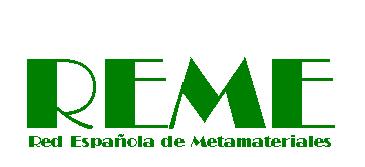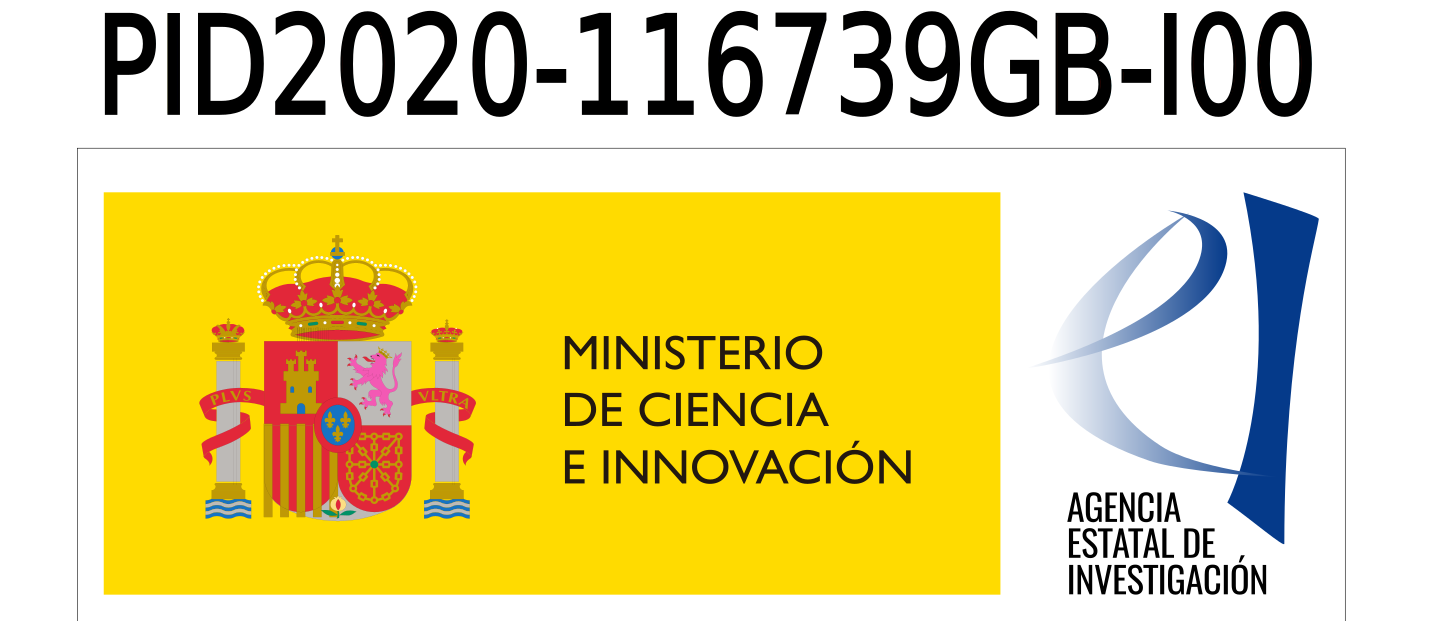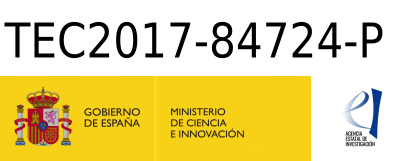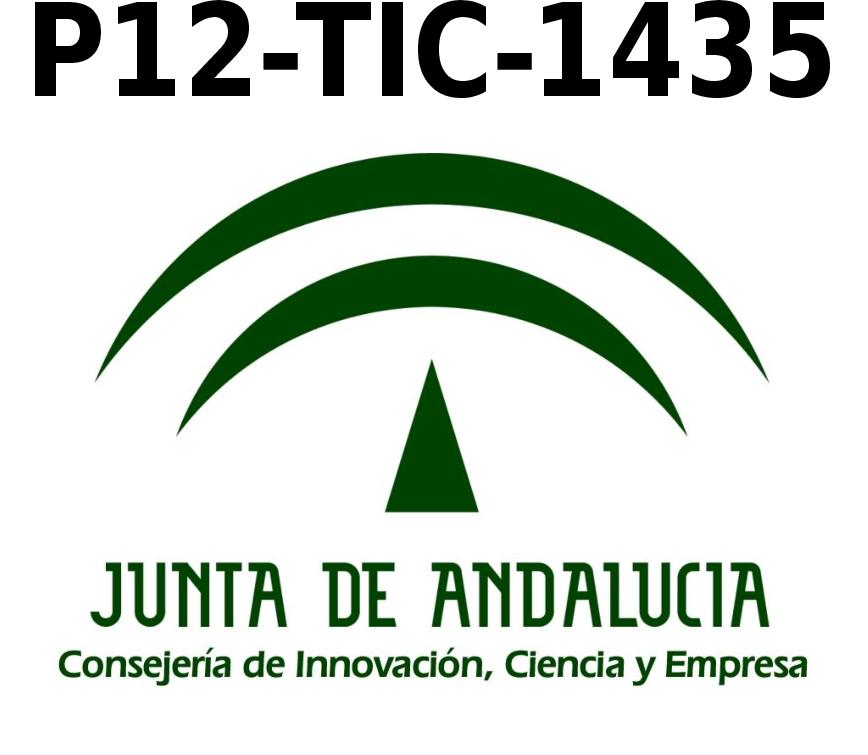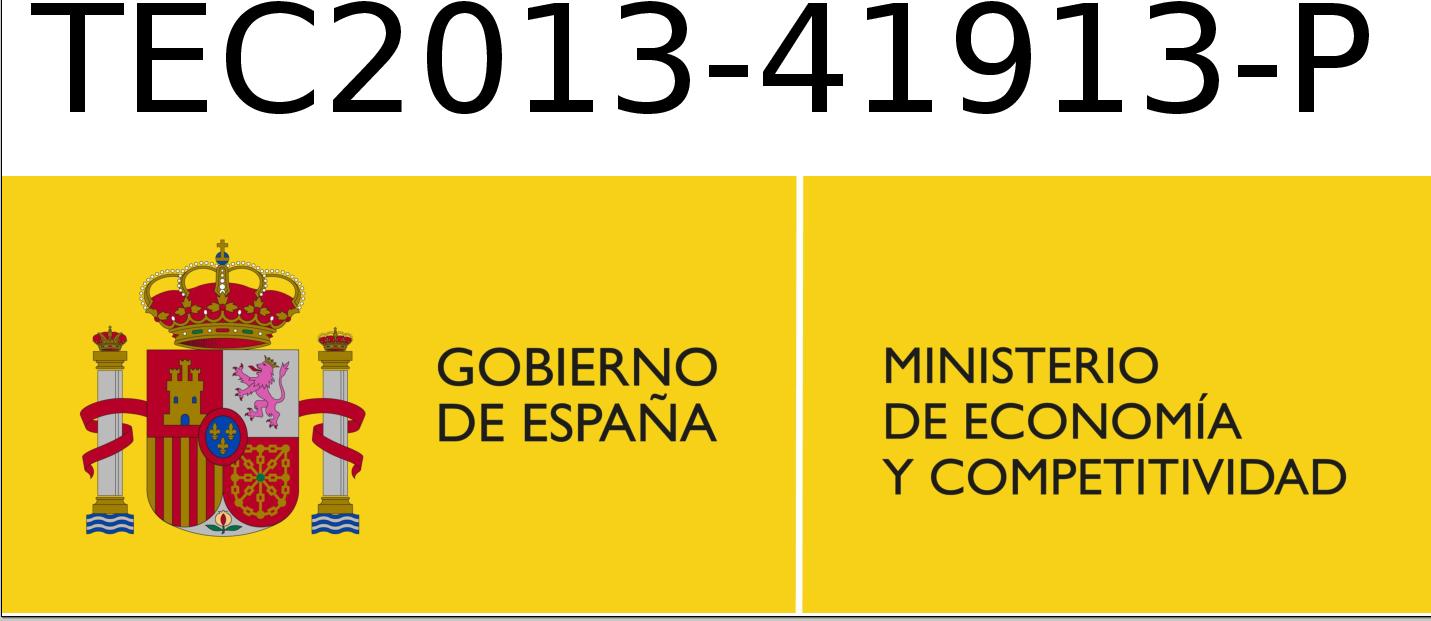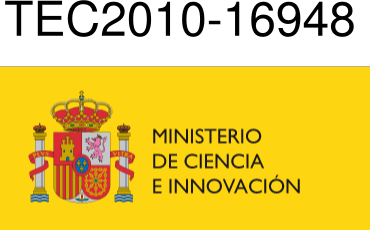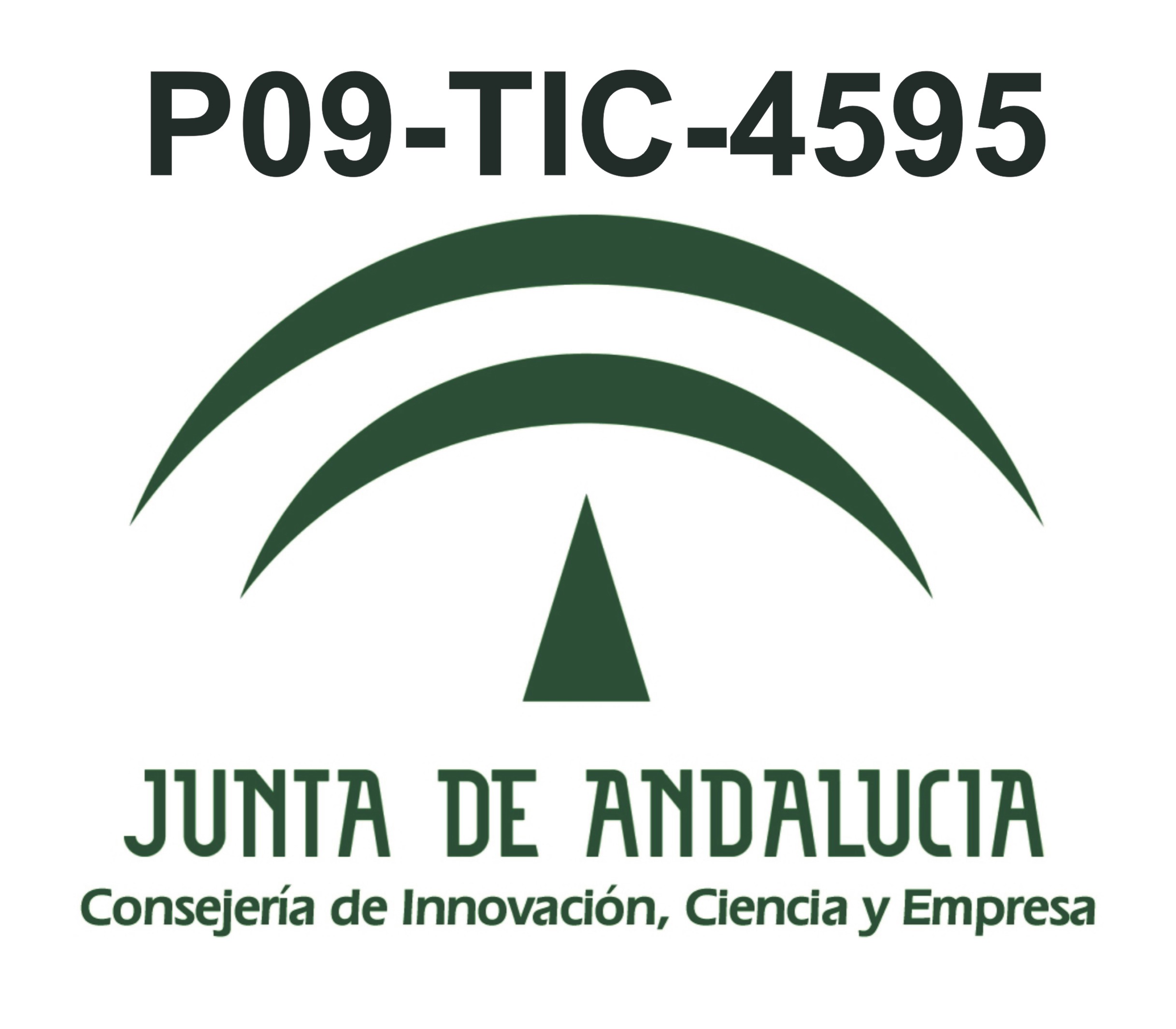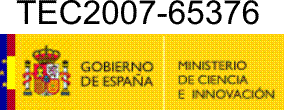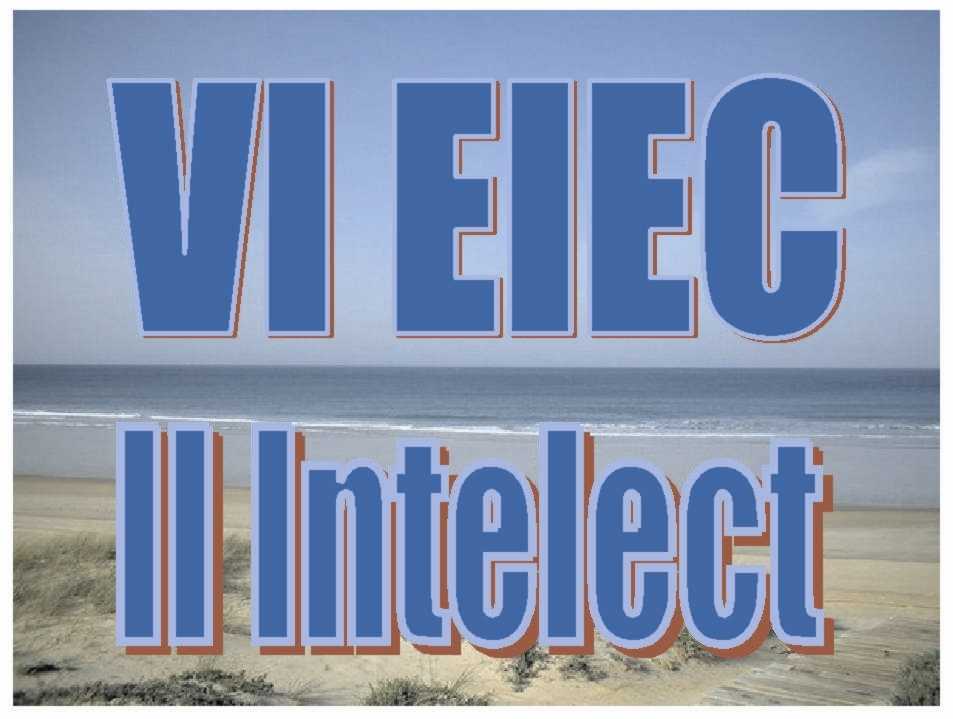Resultados del Proyecto de Excelencia P09-TIC-4575
EN ESTA SECCIÓN SE INCLUYEN LAS PUBLICACIONES QUE DESCRIBEN LOS RESULTADOS DEL PROYECTO
- ARTÍCULOS EN REVISTAS ISI
- M.C. Velázquez-Ahumada, J. Martel, F. Medina, F. Mesa,
"Application of stub loaded folded stepped impedance resonators to dual band filter design,"
Progress in Electromagnetics Research, PIER 102, 107-124, febrero 2010.
Abstract: In this paper, a folded stepped impedance resonator (SIR), modified by adding an inner quasi-lumped SIR stub, is used as a basis block for a new implementation of dual-band bandpass filters. The main advantage of the proposed filter is to make it possible to independently control the electrical features of the first and second bands. The behavior of the first band basically depends on the geometry of the outer folded SIR. The second band, however, is strongly influenced by the presence of the inner stub. Additional design flexibility is achieved by allowing the inner stub to be located at an arbitrary position along the high impedance line section of the main SIR. The position of the tapped input and output lines can be optimized in order to reach a reasonable matching of the filter at the central frequencies of both passbands. Some designs are reported to illustrate the possibilities of the proposed structure. Experimental verification has been included.
-
Raúl Rodríguez-Berral, Francisco Mesa, and Francisco Medina,
"Circuit model for a periodic array of slits sandwiched between two dielectric slabs,"
Applied Physics Letters, 96, pp. 161104(1-3), abril 2010.
Abstract: This paper proposes an equivalent circuit model that uses lumped elements and transmission lines to explain the transmission of electromagnetic waves through a conducting screen periodically perforated with slits and sandwiched between two different dielectric slabs. The present model relies on the impedance-matching point of view, previously introduced by some of the authors, rather than on the surface plasmon polariton concept. Thus, the model constitutes a simple and insightful framework that easily leads to accurate qualitative and quantitative predictions about the nature of the transmission spectrum of such structures.
- Francisco Medina, Francisco Mesa, Jorge. A. Ruiz-Cruz, Jesús M. Rebollar, and José R.
Montejo-Garai,
"Study of extraordinary transmission in a circular waveguide system,"
IEEE Transactions on Microwave Theory and Techniques, vol. 58, no. 6, pp. 1532-1542,
junio 2010.
Abstract: Extraordinary transmission through periodic distributions of sub-wavelength holes made in opaque screens has been demonstrated and exhaustively studied along the last decade. More recently, extraordinary transmission has also been predicted and experimentally observed through electrically small diaphragms located inside hollow pipe waveguides. This last phenomenon cannot be explained in terms of surface waves excited along the periodic system (the so-called surface plasmon polaritons). Transverse resonances can be invoked, however, as a sound explanation for extraordinary transmission in this kind of systems. In this paper, a simple waveguide system, exhibiting exactly the same behavior previously observed in periodic 2-D arrays of holes, is analyzed in depth. Analogies and differences with the periodic case are discussed. The theoretical and experimental results reported in this paper provide strong evidence in favor of the point of view emphasizing the concept of impedance matching versus surface wave excitation. The role of material losses is discussed as an important practical issue limiting the maximum achievable subwavelength transmission level. Most of our conclusions can be applied to both periodic arrays of holes and diaphragms in closed waveguides.
- M.C. Velázquez-Ahumada, J. Martel, F. Medina, F. Mesa,
"Design of a band-pass filter using stepped impedance resonators including ground plane windows
and floating conductors,"
Progress in Electromagnetics Research, PIER 105, pp. 31-48, junio 2010.
Abstract: A new type of miniaturized stepped impedance resonator (SIR) for bandpass filter applications is proposed in this paper. The new resonator incorporates a ground plane window with a floating conductor in the backside of the substrate. The ground plane window increase the characteristic impedance of the lines used to implement the inductive region of the quasi-lumped resonator, thus allowing some size reduction. Moreover, the presence of a floating conducting patch printed below the capacitive region of the resonator pushes up the first spurious band of the filter. A meaningful improvement of its out-of-band rejection level is then achieved. The coupling between adjacent resonators is also enhanced thus leading to wider achievable bandwidths. Some filter designs using the new resonator and other standard resonators are included for comparison purposes.
- C.S.R. Kaipa, A.B. Yakovlev, F. Medina, F. Mesa, C.A.M. Butler, A.P. Hibbins,
"Circuit modeling of the transmissivity of stacked two-dimensional metallic meshes,"
Optics Express, 18, no. 13, pp. 13309-13320, junio 2010.
June 2010. Abstract: This paper presents a simple analytical circuit-like model to study the transmission of electromagnetic waves through stacked two-dimensional (2-D) conducting meshes. When possible the application of this methodology is very convenient since it provides a straightforward rationale to understand the physical mechanisms behind measured and computed transmission spectra of complex geometries. Also, the disposal of closed-form expressions for the circuit parameters makes the computation effort required by this approach almost negligible. The model is tested by proper comparison with previously obtained numerical and experimental results. The experimental results are explained in terms of the behavior of a finite number of strongly coupled Fabry-Pérot resonators. The number of transmission peaks within a transmission band is equal to the number of resonators. The approximate resonance frequencies of the first and last transmission peaks are obtained from the analysis of an infinite structure of periodically stacked resonators, along with the analytical expressions for the lower and upper limits of the pass-band based on the circuit model.
- R. Yang, R. Rodríguez-Berral, F. Medina, and Y. Hao,,
"Analytical model for the transmission of electromagnetic waves through arrays of slits in
perfect conductors and lossy metal screens,"
Journal of Applied Physics, 109, 103107, mayo 2011.
Abstract: This paper presents a very simple analytical model for the analysis of the resonant transmission of microwaves or millimeter waves through periodically distributed slits in a thick metal screen. The model is based on equivalent circuits consisting of transmission line elements of known characteristic admittances and propagation constants loaded by capacitors. Closed-form analytical expressions are provided for all the circuit parameters. Alternatively, the circuit parameters can be quickly computed from numerical simulations carried out at a few frequency points. The proposed analytical model accounts for all the details of the observed transmission spectrum, including conventional Fabry-Perot (FP) resonances, which are controlled by the thickness of the screen, as well as extraordinary transmission peaks, which are related to the periodicity. The range of validity of the model as a function of dimensional parameters is discussed. The experimentally observed and numerically predicted redshift of the Fabry-Perot transmission peaks with respect to the ideal Fabry-Pérot resonance condition is accurately accounted for by the capacitors of the model. For narrow slits, the extraordinary transmission peak is linked to the singular behavior of the capacitances at the Rayleigh-Wood anomaly frequency point. Finally, the effect of the lossy nature of the metal screens is included in the model, providing accurate predictions of the transmission losses. Additionally, for lossy screens the model adequately predicts the anomalous behavior of the above mentioned redshift when the slit width becomes comparable to the skin depth in the metal, which is in good agreement with experimental and theoretical data previously reported for a single slit.
- Ana L. Fructos, S. Campione, F. Capolino, F. Mesa,
"Characterization of complex plasmonic modes in two-dimensional periodic arrays of metal
nanospheres,"
Journal of the Optical Society of America B, 28, pp. 1446-1458, junio 2011.
Abstract: Two-dimensional periodic arrays of noble metal nanospheres support a variety of optical phenomena, including bound and leaky modes of several types. The scope of this paper is the characterization of the modal dispersion diagrams of planar arrays of silver nanospheres, with the ability to follow individual modal evolutions. The metal spherical nanoparticles are described using the single dipole approximation technique by including all the retarded dynamic field terms. Polarizability of the nanospheres is provided by the Mie theory. Dispersion diagrams for both physical and nonphysical modes are shown for a square lattice of Ag nanospheres for the case of lossless and lossy metal particles, with dipole moments polarized along the x, y, and z directions. Though an array with one set of parameters has been studied, the analysis method and classification are general. The evolution of modes through different Riemann sheets and analysis of guidance and radiation are studied in detail.
- Y. R. Padooru, A. B. Yakovlev, C.S.R. Kaipa, F. Medina, F. Mesa.
"Circuit modeling of multi-band high-impedance surface absorbers in the microwave regime,"
Physical Review B (Condensed Matter and Materials Physics), 84, no. 3, 035108 (11
páginas), July 2011.
Abstract: In this paper, we present a simple circuit model to study the absorption of electromagnetic waves by a multilayer structure with a high impedance surface in the microwave regime. The absorber consists of a stack of two-dimensional arrays of sub-wavelength meshes or patches separated by dielectric slabs and backed by a metallic ground plane, with a single resistive sheet placed on the top layer. We observe the appearance of low-frequency resonances of total absorption, which have been identified as the resonances of Fabry-Perot type associated with the individual reactively loaded dielectric slabs (that are strongly coupled through the subwavelength grids). It is shown that these resonances lie within certain characteristic frequency band defined by the structural parameters of the absorber. The observed resonances are characterized by studying the electromagnetic field behavior using the circuit model and full-wave numerical program. In addition, we show that the patch array absorber provides stable resonances with respect to the angle and the polarization of obliquely incident plane waves.
- Ana L. Fructos, Rafael R. Boix, Francisco Mesa,
"Efficient computation of the off-diagonal elements of the vector-potential multilayered periodic
dyadic Green's function,"
IEEE Transactions on Antennas and Propagation, 59, no. 7, pp. 2557-2564, July 2011.
Abstract: The authors focus on the efficient computation of the slowly convergent infinite series that lead to the off-diagonal elements of the vector potential multilayered periodic dyadic Green’s function. Two different approaches based on Kummer's transformation are applied to the evaluation of these series. The well-known approach that makes use of the generalized pencil of functions (GPoF) and Ewald's method is the fastest approach, but it does not provide accurate results when the distance between the field point and any of the source points is close to zero. To avoid this problem, we present a novel approach based on the GPoF and the spectral Kummer-Poisson's method with higher-order asymptotic extraction. This latter approach is slightly slower than the former one, but it is accurate in the whole range of distances between the field point and the sources.
- R. Rodríguez-Berral, F. Medina, F. Mesa, M. García-Vigueras,
"Quasi-analytical modeling of transmission/reflection in strip/slit gratings loaded with
dielectric slabs,"
IEEE Transactions on Microwave Theory and Techniques, 60, no. 3, pp. 405-418, March
2012.
Abstract: This paper presents a quasi-analytical approach to study the classic topic of transmission/reflection of electromagnetic waves through 1-D periodic arrays of strips/slits in metal screens. The approach is based on standard waveguide discontinuity theory. Starting from field equations, it is inferred a circuit-like reduced-order model with just one parameter to be determined. The value of this parameter can be obtained from the transmission/reflection coefficient provided by any full-wave method at just one single frequency. In this way, the computation effort to obtain very wide-band responses of periodically distributed slits or strips under oblique TE/TM illumination in the presence of loading dielectric slabs is reduced to the full-wave analysis of the structure at a single frequency value. For relatively narrow strip/slit gratings, this procedure gives very accurate results even for very complicated transmission/reflection spectra. An additional advantage of the present approach is that it allows for an easy understanding of the underlying physics of the phenomena involved.
- A. Fernández-Prieto, J. Martel, F. Medina, F. Mesa,
"Bandpass and bandstop filters based on open stubs with slots in the ground plane,"
Microwave and Optical Technology Letters, 54, no. 5, pp. 1242-1246, mayo 2012.
Abstract: This work reports on a modified version of lambda/2 open stubs bandpass filters (lambda/2-OSBPFs) and lambda/4 open stubs bandstop filters (lambda/4-OSBSFs) for wide/narrow bandwidth operation. When wide bandwidths (for lambda/2-OSBPF) or narrow bandwidths (for lambda/4-OSBSF) are required, conventional microstrip implementation of this kind of filters is not possible owing to unattainable high stub characteristic impedance values, which lead to extremely narrow strips. To overcome this drawback, we propose the introduction of slots under the stubs along the grounded backside of the substrate. This provides additional flexibility for the width of the strips printed on the upper side of the substrate, which can be much wider than without the slots. To avoid undesired resonances of the slot mode and radiation problems, printed narrow strip short circuits are distributed along the slotted regions. It is shown that the presence of these strips does not meaningfully affect the filter performance while suppresses the undesired slot mode effects.
- C.S.R. Kaipa, A. B. Yakovlev, G. W. Hanson, Y. R. Padooru, F. Medina, F. Mesa,
"Enhanced transmission with a graphene-dielectric micro-structure at low-terahertz,"
Physical Review B (Condensed Matter and Materials Physics), 85, no. 24, pp.
245407-(1-6), junio 2012.
Abstract: Here, we report on the transmissivity of electromagnetic waves through a stack of monolayer graphene sheets separated by dielectric slabs at low-terahertz frequencies. It is observed that the multilayer structure possesses band-gap properties and supports a series of bandpass and band-stop regions, similar to the cases of stacked metallic meshes separated by dielectric slabs at microwave/THz frequencies and a metal-dielectric stack at optical frequencies. The transmission resonances in the bandpass region are identified as coupled Fabry-Pérot resonances associated with the individual cavities of dielectric slabs loaded with graphene sheets. It is also noticed that these resonances lie within a certain characteristic frequency band, independent of the number of layers in the graphene-dielectric stack. The study is carried out using a simple analytical transfer-matrix approach or, equivalently, a circuit-theory model, resulting in the exact solution for the multiple dielectric/graphene sheet surface-conductivity model. Also, an independent verification of the observed phenomena is obtained with commercial numerical simulations.
- El-Mokhtar Hamham, F. Mesa, F. Medina, M. Khalladi,
"Surface-impedance quasi-transverse electromagnetic approach for the efficient calculation of
conductor losses in multilayer single and coupled microstrip lines,"
IET Microwaves, Antennas & Propagation, 6, no. 5, pp. 519-526, June 2012.
Abstract: In this study the authors present a new surface-impedance model for the accurate computation of the effect of metal losses on the parameters of printed microstrip lines. The novelty of the authors approach lies in the fast and direct calculation of the tangential magnetic fields above and below the strip conductors, which allows us to develop a very efficient quasi-transverse electromagnetic (TEM) solution for the conductor losses of multilayer single or coupled microstrip lines. The overall computational effort of the authors's method is much less than that required by purely numerical approaches. The accuracy of the method has been verified by comparison with other techniques, including a general-purpose full-wave finite elements method. It is also shown that the proposed method provides better results than other previously surface-impedance approaches.
- C.S.R. Kaipa, A.B. Yakovlev, F. Medina, and F. Mesa,
"Transmission through stacked 2-D periodic distributions of square conducting patches,"
Journal of Applied Physics, 112, pp. 033101-(1-11), August 2012.
Abstract: In this paper, we study the transmissivity of electromagnetic waves through stacked two-dimensional printed periodic arrays of square conducting patches. An analytical circuit-like model is used for the analysis. The model accounts for the details of the transmission spectrum provided that the period of the unit cell of each patterned layer is well below the wavelength in the dielectric slabs separating the printed surfaces. In particular, we analyze the low-pass band and rejection band behavior of the multilayer structure, and the results are validated by comparison with a computationally intensive finite element commercial electromagnetic solver. The limiting case of an infinite periodic structure is analytically solved and the corresponding band structure is used to explain the passband/stopband behavior of finite structures. In addition, we study in depth the elementary unit cell consisting of a single dielectric slab coated by two metal patch arrays, and its resonance behavior is explained in terms of Fabry-Pérot resonances when the electrical thickness the slab is large enough. In such case, the concept of equivalent thickness of the equivalent ideal Fabry-Pérot resonator is introduced. For electrically thinner slabs it is also shown that the analytical model is still valid, and its corresponding first transmission peak is explained in terms of a lumped-circuit LC resonance.
- J. Naqui, A. Fernández-Prieto, M. Durán-Sindreu, F. Mesa, J. Martel, F. Medina, F. Martín,
"Common-mode suppression in microstrip differential lines by means of complementary split ring
resonators: theory and applications,"
IEEE Transactions on Microwave Theory and Techniques, 60, no. 10, pp. 3023-3034,
October 2012. (Note: this paper was awarded with the Universidad de Sevilla prize to "Trabajos de
Especial Relevancia").
Abstract: This paper is focused on the application of complementary split-ring resonators (CSRRs) to the suppression of the common (even) mode in microstrip differential transmission lines. By periodically and symmetrically etching CSRRs in the ground plane of microstrip differential lines, the common mode can be efficiently suppressed over a wide band whereas the differential signals are not affected. Throughout the paper, we present and discuss the principle for the selective common-mode suppression, the circuit model of the structure (including the models under even- and odd-mode excitation), the strategies for bandwidth enhancement of the rejected common mode, and a methodology for common-mode filter design. On the basis of the dispersion relation for the common mode, it is shown that the maximum achievable rejection band-width can be estimated. Finally, theory is validated by designing and measuring a differential line and a balanced bandpass filter with common-mode suppression, where double-slit CSRRs (DS-CSRRs) are used in order to enhance the common-mode rejection bandwidth. Due to the presence of DS-CSRRs, the balanced filter exhibits more than 40 dB of common-mode rejection within a 34% bandwidth around the filter pass band.
- M. García-Vigueras, F. Mesa, F. Medina, R. Rodríguez-Berral, J. L. Gómez-Tornero,
"Simplified circuit model for metallic arrays of patches sandwiched between dielectric slabs
under arbitrary incidence,"
IEEE Transactions on Antennas and Propagation, 60, no. 10, pp. 4637-4649, October
2012.
Abstract: This work presents an equivalent circuit to model the transmission/reflection of a plane wave that impinges obliquely on a periodic arrangement of metallic rectangular dipoles embedded between two dielectric slabs. The equivalent circuit takes advantage of the periodicity of the structure to reformulate the original problem as a certain equivalent waveguide scattering problem. Equivalent transmission lines are used to simulate the wave propagation whereas equivalent lumped circuit elements account for presence of the metallic patches. The obtaining of the circuit parameters is carried out via a systematic procedure, which provides a robust strategy that gives rise to surprisingly accurate results even for rather complex situations. The proposed equivalent circuit model simplifies considerably the original complex electromagnetic problem and provides a valuable physical insight into the parameters that are relevant in the phenomenon as well as an in-depth understanding of the operation principles of the periodic surface. Thus, the reported reduced-order model of the corresponding scattering problem can be a very convenient and helpful tool for the analysis and/or design of many practical devices.
- Y. R. Padooru, A. B. Yakovlev, C. S. R. Kaipa, G. W. Hanson, F. Medina, F. Mesa, A. W. Glisson,
"New absorbing boundary conditions and analytical model for multilayered mushroom-type
metamaterials: applications to wideband absorbers,"
IEEE Transactions on Antennas and Propagation, 60, no. 12, pp. 5727-5742,
December 2012.
Abstract: An analytical model is presented for the analysis of multilayer wire media loaded with 2-D arrays of thin material terminations, characterized in general by a complex surface conductivity. This includes the cases of resistive, thin metal, or graphene patches and impedance ground planes. The model is based on the nonlocal homogenization of the wire media with additional boundary conditions (ABCs) at the connection of thin (resistive) material. Based on charge conservation, new ABCs are derived for the interface of two uniaxial wire mediums with thin imperfect conductors at the junction. To illustrate the application of the analytical model and to validate the new ABCs, we characterize the reflection properties of multilayer absorbing structures. It is shown that in such configurations the presence of vias results in the enhancement of the absorption bandwidth and an improvement in the absorptivity performance for increasing angles of an obliquely incident TM-polarized plane wave. The results obtained using the analytical model are validated against full-wave numerical simulations.
- R. Rodríguez-Berral, C. Molero, F. Medina, F. Mesa,
"Analytical wideband model for strip/slit gratings loaded with dielectric slabs,"
IEEE Transactions on Microwave Theory and Techniques, 60, no. 12, pp. 3908-3918,
December 2012.
Abstract: This paper presents a fully analytical model to determine the transmission and reflection properties of planar 1-D distributions of metal strips or slits made in thin metal screens. In contrast with other analytical or quasi-analytical approaches, the formulation incorporates the presence of dielectric slabs and is valid over a wide frequency band, from the long wavelength limit to the grating lobes operation. The model has been adapted to the case where two 1-D planar grids are stacked or a single grid is printed on a grounded substrate. In these cases, the model rigorously takes into account higher order mode interaction between the two stacked arrays of strips/slits or with the ground plane. Oblique incidence and both TE and TM polarizations have been considered. The analytical results show a good agreement with those computed by high-performance numerical methods, accounting for very fine details of extremely complicated transmission/reflection spectra. These results are of straightforward application to a variety of practical situations from microwaves to the terahertz regime. The present methodology can still be useful at higher frequencies provided that adequate models of the planar conductors are incorporated. In general, the model provides physical insight on the nature of the expected spectra and facilitates the design of devices based on planar metallic gratings.
- D. González-Ovejero, F. Mesa, C. Craeye,
"Accelerated macro basis functions analysis of finite printed antenna arrays through 2D and 3D
multipole expansions,"
IEEE Transactions on Antennas and Propagation, 61, no. 2, pp. 707-716, February 2013.
Abstract: An efficient technique is presented for the analysis of finite printed antenna arrays made of identical elements. It is based on a closed-form expression for the spatial-domain Green's function (GF) given as a finite sum of cylindrical waves (obtained through rational function fitting) plus one spherical wave. From there, a multipole expansion can be obtained for planar layered medium GFs. The macro basis function (MBF) technique is applied to the method of moments (MoM) solution of a mixed-potential integral equation, this reduces the size of the MoM impedance matrix and allows for a direct solution. However, the evaluation of the entries of this reduced matrix becomes the dominant contribution to the total computation time. The aforementioned multipole expansion is exploited to provide a fast construction of the reduced MoM matrix, whose elements are the reaction integrals between the MBFs considered to characterize the currents on the array element. The complexity of evaluating the interactions between MBFs is found to be dominated by the calculations related to the spherical wave term. Thus, taking into account the layered medium does not increase the order of the complexity with respect to a multipole-accelerated computation of reaction integrals in a homogeneous medium.
- R. Florencio, R. R. Boix, E. Carrasco, J. A. Encinar, V. Losada,
"Efficient numerical tool for the analysis and design of reflectarrays based on cells with three
parallel dipoles,"
Microwave and Optical Technology Letters, 55, no. 6, pp. 1212-1216, June 2013.
Abstract: In this article, the Method of Moments in the spectral domain (MoM-SD) is applied to the analysis of multilayered periodic structures, containing three coplanar parallel dipoles in the unit cell. It is shown that the use of basis functions with edge singularities in the modeling of the current density on the dipoles leads to important computer memory and CPU times savings in the analysis of the periodic structures. The MoM-SD home-made software is used in the analysis of a shaped beam reflectarray antenna made of cells with three parallel dipoles under the local periodicity assumption. The numerical results obtained for the radiation pattern of the antenna are compared with numerical results provided by the commercial software CSTV and with measurements and good agreement is found.
- Safae El Amrani, R. Rodríguez-Berral, F. Mesa, M. Boussouis,
"Comprehensive study of the spurious effects on the signal guidance in coplanar waveguides,"
IEEE Transactions on Electomagnetic Compatibility, in press.
Abstract: A study of the propagation characteristics and several signal integrity aspects of a conventional coplanar waveguide (CPW) is presented here. The study considers the bound and leaky modes supported by this structure up to high frequencies. The analysis of the dispersion characteristics of the structure is complemented with the study of the voltage excited along the line when fed by a delta-gap source of current. The results thus obtained allow us to discuss on the physical meaning of the modes and the relevance of the residual wave, which is key to link the practical role played by the different modal solutions with the spurious effects that may appear in the structure. The analysis of the eye-diagram performance also reveals that the signal integrity in CPW systems basically relies on the excitation of the parasitic fundamental coupled slotline mode as well as the high-frequency excitation of the continuous spectrum. These aspects have been studied in detail.
- R. Florencio, R. R. Boix, J. A. Encinar,
"Enhanced MoM analysis of the scattering by periodic strip gratings in multilayered substrates,"
IEEE Transactions on Antennas and Propagation, 61, no. 10, pp. 5088-5099, October
2013.
Abstract: The method of moments (MoM) is applied to the analysis of the scattering of a multilayered periodic strip grating by a plane wave with oblique incidence and arbitrary polarization. Although this problem has been traditionally solved by means of the MoM in the spectral domain, this is an approach which leads to the computation of slowly convergent infinite summations. In this paper, the problem is solved by means of the mixed potential integral equation (MPIE) formulation of the MoM in the spatial domain. While applying the MoM in the spatial domain, two improvements are introduced which lead to important CPU time savings. First, the multilayered periodic Green's functions are accurately interpolated in terms of Chebyshev polynomials. Second, half the integrals involved in the computation of the MoM matrix entries are obtained in closed form. As a consequence of these two improvements, the spatial domain version of the MoM presented in this paper turns out to be between one and two orders of magnitude faster than the conventional spectral domain version when basis functions that account for edge singularities are used in the modeling of the current density on the metallizations.
- R. Florencio, R. R. Boix, E. Carrasco, J. A. Encinar, M. Barba, G. Pérez-Palomino,
"Broadband reflectarrays made of cells with three parallel dipoles,"
Microwave and Optical Technology Letters, vol. 56, no. 3, pp. 748-753, March 2014.
Abstract: A broadband reflectarray cell made of three parallel dipoles printed on a dielectric layer is presented. A 33 % bandwidth is achieved for the cell made of dipoles, which is larger than that obtained for a reference cell consisting of three stacked square patches (26%). Using this cell, a 41-cm reflectarray antenna has been designed to produce a collimated beam at 9.5 GHz. The numerical results obtained for the reflectarray antenna made of parallel dipoles show a 1-dB bandwidth of 19 %, a 65 % efficiency, 0.2 dB of losses, and low levels of cross polarization (25 dB below the maximum). These results demonstrate a high performance for the proposed reflectarray antenna made of cells with three printed dipoles.
Go up
- M.C. Velázquez-Ahumada, J. Martel, F. Medina, F. Mesa,
"Application of stub loaded folded stepped impedance resonators to dual band filter design,"
Progress in Electromagnetics Research, PIER 102, 107-124, febrero 2010.
- CONTRIBUCIONES A CONGRESOS INTERNACIONALES
- C.S.R. Kaipa, C.A.M. Butler, A.P. Hibbins, J.R. Sambles, F. Medina, F. Mesa, and A.B. Yakovlev,
"Analytical Modelling and Experimental Verification of Fabry-Pérot Resonances in Multilayer Sub-wavelength
Partially-Reflecting Surfaces,"
2010 European Conference on Antennas and Propagation, (Barcelona, Spain), 12-16 abril 2010, CDROM, 5 pages.
E-ISBN: 978-84-7653-472-4 (IEEE Xplore), Print ISBN: 978-1-4244-6431-9.
- F. Medina and F. Mesa,
"Circuit modeling of extraordinary transmission in periodic structures,"
(INVITED PAPER)
26th International Review of Progress in Applied Computational Electromagnetics, (Tampere, Finland), 26-29 April
2010, CDROM, 5 pages.
- R. Florencio, R. R. Boix, J. A. Encinar,
"Two numerical techniques for the electromagnetic analysis of multilayered periodic structures with application to the
design of reflectarray antennas,"
IV European Conference on Computacional Mechanics, ECCM 2010, (Paris, France), 16-21 May 2010, CDROM, 2 pages.
(invited by the organizer of the session "Advanced methods in computational electromagnetics").
- F. Medina, F. Mesa, R. Rodríguez-Berral, R. Marqués,
"Extraordinary electromagnetic transmission and circuit models,"
VII Encuentro Ibérico de Electromagnetismo Computacional, (Monfragüe, Cáceres, Spain), 19-21 May 2010, CDROM pp.
79-86.
- A.L. Fructos, R.R. Boix, F. Mesa,
"Closed-form uniform asymptotic expansions of multilayered media Green's functions,"
VII Encuentro Ibérico de Electromagnetismo Computacional, (Monfragüe, Cáceres, Spain), 19-21 May 2010, CDROM, 4
pages.
- F. Medina, F. Mesa and R. Marqués,
"A critical review of extraordinary transmission phenomena," (INVITED TALK)
Days on Diffraction 2010, (Saint Petersburg, Russia), 8-11 June 2010, Abstracts Book, p. 117.
- R. Rodríguez-Berral, F. Mesa, F. Medina,
"Transmission through slit diffraction gratings with dielectric slabs: equivalent circuit model,"
Days on Diffraction 2010, (Saint Petersburg, Russia), 8-11 June 2010, Abstracts Book, p. 125.
- F. Medina, F. Mesa, A.B. Yakovlev, R.R. Berral, and M. García-Vigueras,
"Overview on the Use of Circuit Models to Analyze Extraordinary Transmission and Other Related Phenomena," (INVITED TALK),
2010 IEEE AP-S/URSI-USNC International Symposium (ISBN: 978-1-4244-4968-2/10), (Toronto, Canada), 11-17 July
2010.
- R.R. Boix, F. Mesa, A.L. Fructos,
"Relay-race closed form expressions of Green's functions for planar layered media,"
2010 IEEE AP-S/URSI-USNC International Symposium (ISBN: 978-1-4244-4968-2/10), (Toronto, Canada), 11-17 July
2010, CDROM, 4 pages.
- R. Rodríguez-Berral, F. Medina, and F. Mesa,
"Circuit Modeling of the Transmissivity of a Slit Difraction Grating Embedded in Dielectric Slabs,"
2010 IEEE AP-S/URSI-USNC International Symposium (ISBN: 978-1-4244-4968-2/10), (Toronto, Canada), 11-17 July
2010.
- F. Medina, F. Mesa, R. Rodríguez-Berral, and R. Marqués,
"Advances on circuit modeling of extraordinary transmission,"
font color="blue">(INVITED TALK, PLENARY SESSION),
13th International Conference on Mathematical Methods in Electromagnetic Theory, MMET 2010 (ISBN:
978-1-4244-8860-5/10), (Kiev, Ukraine), 6-8 September 2010, 6 pages.
- F. Medina, F. Mesa, J.A. Ruiz-Cruz, J.M. Rebollar, J.R. Montejo-Garai,
"Extraordinary transmission inside closed waveguides," (INVITED TALK),
Fourth International Congress on Advanced Electromagnetic Materials in Microwaves and Optics, Metamaterials 2010
(ISBN: 978-952-92-7734-6), (Karlsruhe, Germany), 13-16 September 2010, pp. 718-720.
- A. L. Fructos, R. R. Boix, F. Mesa, "A contribution to the efficient computation of multilayered Green's functions," IV LEMA-EPFL Workshop on Integral Techniques for Electromagnetics, INTELECT 2010, (Les Diablerets, Switzerland), 1 October 2010 (electronic publication, 32 slides).
- R. Florencio, R. R. Boix, J. A. Encinar, "Considerations on the method of moments analysis of periodic multilayered structures with application to the design of reflectarray antennas," \textit{IV LEMA-EPFL Workshop on Integral Techniques for Electromagnetics, INTELECT 2010}, (Les Diablerets, Switzerland), 1 October 2010 (electronic publication, 25 slides).
- F. Mesa, F. Medina, R. Rodríguez-Berral,
"On the circuit modeling of extraordinary-transmission phenomena," (INVITED TALK),
3rd Mediterranean Conference on Nanophotonics, Medinano-3 (Belgrade, Serbia), 18-19 October 2010.
- R. Rodríguez-Berral, F. Medina, F. Mesa,
"Analytical Modeling of Extraordinary Transmission in the Presence of Dielectric Slabs," (INVITED
TALK), Progress in Electromagnetic Research Symposium, PIERS 2011 (Marrakesh, Morocco), 20-23 March 2011.
- A. L. Fructos, R.R. Boix, F. Mesa,
"A contribution to the efficient computation of multilayered periodic Green's functions,"
(CONVENED PAPER)
5th European Conference on Antennas and Propagation, EuCAP 2011 (ISBN: 978-1-4577-0250-1), (Rome, Italy), pp.
2471-2474, 11-15 April 2011.
- C. S. R. Kaipa, A. Yakovlev, F. Medina, F. Mesa, Y. R. Padooru,
"Sub-wavelength Transmission Through Stacked Two-dimensional Metallic Patches: A Circuit Model Perspective,"
2011 IEEE-AP-URSI/USNC Symposium (ISBN: 978-1-4244-9561-0), (Spokane, WA, USA), 3-8 July 2011.
- G. Bigel, F. Medina, F. Mesa, R. Rodríguez-Berral,
"Transmission of EM waves through arrays of stepped subwavelength slits,"
2011 IEEE-AP-URSI/USNC Symposium (ISBN: 978-1-4244-9561-0), (Spokane, WA, USA), 3-8 July 2011.
- R. Florencio, Rafael R. Boix and J. A. Encinar,
"Pole-zero matching technique for multilayered periodic structures with application to
the design of reflectarray antennas,"
2011 IEEE AP-S/URSI-USNC International Symposium (ISBN: 978-1-4244-9561-0), (Spokane, Washington, USA), 3-8 July
2011, CDROM, 4 pages.
- F. Medina, F. Mesa, D. Skigin,
"Analytical modeling of compound metallic reflection gratings,"
2011 IEEE-AP-URSI/USNC Symposium (ISBN: 978-1-4244-9561-0), (Spokane, WA, USA), 3-8 July 2011.
- Y. R. Padooru, A. B. Yakovlev, C. S. R. Kaipa, F. Medina, F. Mesa,
"Multi-band High-Impedance Surface Absorbers with a Single Resistive Sheet: Circuit Theory Model,"
2011 IEEE-AP-URSI/USNC Symposium (ISBN: 978-1-4244-9561-0), (Spokane, WA, USA), pp. 2264-2267, 3-8 July 2011.
- A. L. Fructos, R. R. Boix, F. Mesa,
"New Developments for the Efficient Computation of Multilayered Periodic Green's Functions,"
2011 IEEE-AP-URSI/USNC Symposium (ISBN: 978-1-4244-9561-0), (Spokane, WA, USA), pp. 2264-2267, 3-8 July 2011.
- F. Mesa, F. Medina, M. García-Vigueras, R. Rodríguez-Berral, J. L. Gómez-Tornero,
"Circuit Approach for a General Study of Frequency Selective Surfaces," (INVITED)
2001 International Conference on Electromagnetics in Advanced Applications (ICEAA'11) (ISBN: 978-1-61284-978-2),
(Torino, Italy), pp. 122-125, 12-16 September 2011.
- F. Mesa, D. González-Ovejero, C. Craeye, and R. R. Boix,
"Hankel expansion of Green's functions applied to a multipole accelerated Macro Basis Functions analysis,"
V LEMA-EPFL Workshop on Integral Tech. for Electromagnetics (INTELECT) (Florence, Italy), 9 September 2011.
- F. Medina, G. Bigel, F. Mesa, R. Rodríguez-Berral,
"Analytical modeling of structured 1D diffraction gratings using a microwave engineering approach,"
Proc. of the 41st European Microwave Conference (ISBN: 978-2-87487-022-4), (Manchester, UK), pp.
814-817, 9-14 octubre 2011.
- A. Fernández-Prieto, J. Martel, J. S. Hong, F. Medina, S. Qian and F. Mesa,
"Differential transmission line for common-mode suppression using double side MIC technology,"
Proc. of the 41st European Microwave Conference (ISBN: 978-2-87487-022-4), (Manchester, UK), pp.
631-634, 9-14 octubre 2011.
- A. Fernández-Prieto, J. Martel, F. Medina, F. Mesa, S. Qian, J.-S. Hong,
"Microstrip/CPW differential lines for common-mode suppression,"
Fifth International Congress on Advanced Electromagnetic Materials in Microwaves and Optics, Metamaterials 2011
(ISBN: 978-952-67611-0-7), (Barcelona, Spain), pp. 313-315, 10-15 octubre 2011.
- F. Medina, G. Bigel, F. Mesa, R. Rodríguez-Berral,
"Closed-form analysis of electrically thick diffraction gratings with internal structure,"
Fifth International Congress on Advanced Electromagnetic Materials in Microwaves and Optics, Metamaterials 2011
(ISBN: 978-952-67611-0-7), (Barcelona, Spain), pp. 733-735, 10-15 octubre 2011.
- R. Rodríguez-Berral, F. Mesa, F. Medina,
"Analytical model for periodic arrays of slits/strips printed on dielectric slabs: TE and TM polarizations,"
Fifth International Congress on Advanced Electromagnetic Materials in Microwaves and Optics, Metamaterials 2011
(ISBN: 978-952-67611-0-7), (Barcelona, Spain), pp. 739-741, 10-15 octubre 2011.
- R. Rodríguez-Berral, F. Medina, F. Mesa, M. García-Vigueras, J. L. López-Tornero,
"Recent advances in circuit modeling of the transmission of electromagnetic waves through periodic screens,"
8th Iberian Meeting on Computational Electromagnetics, (Sesimbra, Portugal), (4 pages), 02 noviembre 2011.
- A. Fernández-Prieto, M. C. Velázquez-Ahumada, J. Martel, F. Medina, F. Mesa,
"Nuevas aportaciones al diseño de filtros microtira y líneas diferenciales del Grupo de Microondas de la Universidad de
Sevilla," 8th Iberian Meeting on Computational Electromagnetics, (Sesimbra, Portugal), (4 pages), 02 noviembre
2011.
- R. Florencio, R. R. Boix, J. A. Encinar,
"Efficient analysis of multilayered periodic structures with application to the design of reflectarray antennas,"
8th Iberian Meeting on Computational Electromagnetics, (Sesimbra, Portugal), (4 pages), 02 noviembre 2011.
- F. Medina, F. Mesa, R. Rodríguez-Berral,
"Advances on the analytical modeling of 1D and 2D metallic gratings," (INVITED, PLENARY SESSION)
2nd Conference on Waves in Science and Engineering, WISE 2011, (Mexico City, Mexico), 7-11 noviembre 2011.
- Y.R. Padooru, A.B. Yakovlev, C.S.R. Kaipa, G.W. Hanson, F. Medina, F. Mesa, A.W. Glisson,
"Absorbing Boundary Conditions and Homogenization Model for Multilayered Wire Media,"
Proc. of 2012 USNC/URSI National Radio Science Meeting, (Boulder, CO, USA), Jan. 4-7, 2012.
- R. Rodríguez-Berral, F. Mesa, F. Medina,
"Analytical Model for TM Scattering of 1-D Narrow Slit Gratings Loaded with Dielectric Slabs,"
6th European Conference on Antennas and Propagation, EuCAP 2012, (ISBN: 978-1-4577-0919-7), (Pragha, Chezc
Republic), pp. 3089-3093, 26-30 March 2012.
- R. Florencio, R. R. Boix, J. A. Encinar,
"Efficient analysis of multi-resonant periodic structures for the improved analysis and design of reflectarray
antennas,"
6th European Conference on Antennas and Propagation, EuCAP 2012, (Pragha, Chezc Republic), pp. 2654-2657, 26-30
March 2012.
- R. Florencio, R. R. Boix, V. Losada, J. A. Encinar, E. Carrasco, M. Arrebola,
"Comparative study of reflectarrays based on cells with three coplanar dipoles and reflectarrays based on cells with
three stacked patches,"
6th European Conference on Antennas and Propagation, EuCAP 2012, (Pragha, Chezc Republic), pp. 3707-3710, 26-30
March 2012.
- D. González-Ovejero, F. Mesa, C. Craeye, R. R. Boix,
"Efficient analysis of mutual coupling in periodic and non-periodic printed antenna arrays,"
6th European Conference on Antennas and Propagation, EuCAP 2012, (Pragha, Chezc Republic), pp. 220-223, 26-30
March 2012.
- F. Medina, F. Mesa, R. Rodríguez-Berral,
"Analytical Modelling of Microwave/Millimeter Wave 1D and 2D Gratings and Fishnets,"
(INVITED, FOCUSED SESSION),
4th International Conference SMART, Materials, Structures, Systems, CIMTEC 2012, Focused Session on
Metamaterials, (Montecatini Terme, Italy), 10-14 June 2012.
- C.S.R. Kaipa, A.B. Yakovlev, G.W. Hanson, Y.R. Padooru, F. Medina, F. Mesa,
"Low-Terahertz transmissivity with a graphene-dielectric micro-structure,"
2012 IEEE MTT-S International Microwave Symposium, (ISBN: 978-1-4673-1088-8/12), (Montreal, Canada), 3 pp., 17-22
junio 2012.
- R. Rodríguez-Berral, F. Mesa, F. Medina,
"Fully analytical circuit-like approach for the TE scattering by narrow-slit printed gratings,"
2012 IEEE MTT-S International Microwave Symposium, (ISBN: 978-1-4673-1088-8/12), (Montreal, Canada), 3 pp., 17-22
junio 2012.
- C. S. R. Kaipa, A. B. Yakovlev, G. W. Hanson, Y. R. Padooru, F. Medina, F. Mesa,
"Low-Terahertz transmissivity and broadband planar filters using graphene-dielectric stack,"
2012 IEEE AP-S International Symp. on Antennas and Propagat. and URSI/USNC North America Radio Science Meeting,
(Chicago, IL, USA), abstract, 8-14 julio 2012.
- Y. R. Padooru, A. B. Yakovlev, C. S. R. Kaipa, G. W. Hanson, F. Medina, F. Mesa, A. W. Glisson,
"Generalized additional boundary conditions and analytical model for multilayered mushroom-type wideband absorbers,"
2012 IEEE AP-S International Symp. on Antennas and Propagat., (ISBN:
978-1-4673-0462-7), (Chicago, IL, USA), 2 pp., 8-14 julio 2012.
- G. Pérez-Palomino, J. A. Encinar, M. Barba, R. Dickie, P. Baine, R. Cahill, R. Florencio, R. R. Boix, "Wideband unit cell based on liquid crystals for reconfigurable reflectarray antennas in F-band," 2012 IEEE AP-S International Symp. on Antennas and Propagat., (Chicago, IL, USA), 2 pp., 8-14 julio 2012.
- F. Medina, F. Mesa, R. Rodríguez-Berral,
"Efficient circuit models for extraordinary transmission structures," (INVITED)
Metamaterials 2012: The Sixth International Congress on Advanced Electromagnetic Materials in Microwaves and
Optics, (ISBN: 978-952-67611-2-1), (Saint Petersburg, Russia), pp. 59-61, 17-20 septiembre 2012.
- R. Florencio, R. R. Boix, J. A. Encinar,
"Enhanced Galerkin's analysis of periodic arrays of strips in multilayered substrates,"
VI LEMA-EPFL Workshop on Integral Techniques for Electromagnetics, INTELECT 2012, (Seville, Spain), (34 slides),
19 October 2012.
- D. González-Ovejero, F. Mesa, C. Craeye, R. R. Boix,
"Enhanced analysis of mutual coupling in printed non-periodic antenna arrays,"
VI LEMA-EPFL Workshop on Integral Techniques for Electromagnetics, INTELECT 2012, (Seville, Spain), (29 slides),
19 October 2012.
- F. Medina, R. Rodríguez-Berral, F. Mesa,
"Circuit Model for Metallic Gratings With Tapered and Stepped Slits,"
42nd European Microwave Conference, EuMC 2012, (ISBN: 978-2-87487-027-9), (Amsterdam, The Netherlands), pp.
1225-1228, 29-Oct. to 1-Nov. 2012.
- R. Florencio, R. R. Boix, J. A. Encinar,
"Improvements in the MoM analysis of 2-D planar multilayered periodic structures," (2 páginas)
7th European Conference on Antennas and Propagation, EuCAP 2013, (Goteborg, Suecia), 08 abril 2013.
- R. Florencio, R. R. Boix, J. A. Encinar,
"Improved MoM analysis of periodic multilayered structures. Applications to the analysis and
design of reflectarray antennas,"
9th Iberian Meeting on Computational Electromagnetics, (Dénia, Alicante, Spain), 14 mayo 2013.
- R. Florencio, R. R. Boix, J. A. Encinar,
"Design of a reflectarray antenna at 300 GHz based on cells with three coplanar dipoles,"
2013 IEEE International Symposium on Antennas and Propagation, (Orlando, FL, USA), 7 de julio 2013.
- C.S.R. Kaipa, C.A.M. Butler, A.P. Hibbins, J.R. Sambles, F. Medina, F. Mesa, and A.B. Yakovlev,
"Analytical Modelling and Experimental Verification of Fabry-Pérot Resonances in Multilayer Sub-wavelength
Partially-Reflecting Surfaces,"
2010 European Conference on Antennas and Propagation, (Barcelona, Spain), 12-16 abril 2010, CDROM, 5 pages.
E-ISBN: 978-84-7653-472-4 (IEEE Xplore), Print ISBN: 978-1-4244-6431-9.
- CONTRIBUCIONES A CONGRESOS NACIONALES
- R. Florencio, R.R. Boix, J.A. Encinar,
"Análisis de estructuras multicapa periódicas útiles en el diseño de antenas
reflectarray,"
XXV Symposium Nacional de URSI, (Bilbao), Septiembre 2010, ISBN: 978-84-92812-70-7.
- A. Fernández-Prieto, J. Martel, F. Medina, F. Mesa,
"Diseños de filtros paso de banda y rechazo de banda basados en stubs con ranuras en el plano
de
masa,"
XXV Symposium Nacional de URSI, (Bilbao), Septiembre 2010, ISBN: 978-84-92812-70-7.
- A.L. Fructos, R.R. Boix, F. Mesa,
"Expresiones en forma cerrada para el campo próximo y el campo lejano de funciones de Green no
periódicas en medios multicapa,"
XXV Symposium Nacional de URSI, (Bilbao), Septiembre 2010, ISBN: 978-84-92812-70-7.
- A.L. Fructos, R.R. Boix, F. Mesa,
"Una aportación al cálculo rápido y preciso de funciones de Green periódicas en medios
multicapa,"
XXV Symposium Nacional de URSI, (Bilbao), Septiembre 2010, ISBN: 978-84-92812-70-7.
- El-Mokhtar Hamham, F. Mesa, F. Medina, M. Khalladi,
"Una aproximación cuasi-TEM para el cálculo eficiente de las pérdidas en el conductor en líneas microtiras simples y
acopladas multicapa,"
XXVI Symposium Nacional de URSI, (ISBN: 978-84-933934-5-8), (Leganés, Madrid), Septiembre 2011.
- R. Rodríguez-Berral, F. Medina, F. Mesa, M. García-Vigueras,
"Modelo analítico para rejillas de difracción metálicas cargadas con dieléctricos,"
XXVI Symposium Nacional de URSI, (ISBN: 978-84-933934-5-8), (Leganés, Madrid), Septiembre 2011.
- R. Florencio, J.A. Encinar, R.R. Boix, E. Carrasco, M. Barba, G. Pérez-Palomino,
"Análisis de un elemento para reflectarrays basado en celdas con tres dipolos paralelos,"
XXVI Symposium Nacional de URSI, (ISBN: 978-84-933934-5-8), (Leganés, Madrid), Septiembre 2011.
- M. García-Vigueras, F. Mesa, F. Medina, R. Rodríguez-Berral, J.L. Gómez-Tornero,
"Circuitos equivalentes para el modelado de la reflexión convencional y extraordinaria en arrays de dipolos,"
XXVI Symposium Nacional de URSI, (ISBN: 978-84-933934-5-8), (Leganés, Madrid), Septiembre 2011.
- Safae El Amrani, R. Rodríguez Berral, F. Mesa, M. Boussouis,
"Estudio del espectro modal excitado en una guía coplanar convencional,"
XXVI Symposium Nacional de URSI, (ISBN: 978-84-933934-5-8), (Leganés, Madrid), Septiembre 2011.
- A. Fernández-Prieto, J. Martel, J.-S. Hong, F. Medina, S. Qian, F. Mesa,
"Líneas diferenciales para supresión de modo común usando tecnología MIC de doble cara,"
XXVI Symposium Nacional de URSI, (ISBN: 978-84-933934-5-8), (Leganés, Madrid), Septiembre 2011.
- R. Florencio, R.R. Boix, J.A. Encinar,
"Técnica de ajuste de polos y ceros para estructuras periódicas multicapa con aplicación al diseño de antenas
reflectarray,"
XXVI Symposium Nacional de URSI, (ISBN: 978-84-933934-5-8), (Leganés, Madrid), Septiembre 2011.
- F. Medina,
"Transmisión Extraordinaria vista por un Ingeniero de Microondas,"
XXVII Symposium Nacional de URSI, Actas del congreso en CD-ROM (2 páginas, ISBN: 978-84-695-4327-6),
(CONFERENCIA PLENARIA),
(Elche, Alicante), 12-14 septiembre 2012.
- R. Rodríguez-Berral, F. Mesa, F. Medina,
"Analytical Equivalent Circuit for Slit Gratings in Dielectric-Coated Thick Metallic Screens,"
XXVII Symposium Nacional de URSI, Actas del congreso en CD-ROM (2 páginas, ISBN: 978-84-695-4327-6), (Elche,
Alicante), 12-14 septiembre 2012.
- R. Rodríguez-Berral, F. Medina, F. Mesa,
"Analytical circuit model for metal gratings with nonuniform slits,"
XXVII Symposium Nacional de URSI, Actas del congreso en CD-ROM (2 páginas, ISBN: 978-84-695-4327-6), (Elche,
Alicante), 12-14 septiembre 2012.
- C. Molero, R. Rodríguez-Berral, F. Medina, F. Mesa,
"Analytical Circuit Model for Coupled Strip/Slit Gratings Printed on Dielectric Slabs,"
XXVII Symposium Nacional de URSI, Actas del congreso en CD-ROM (2 páginas, ISBN: 978-84-695-4327-6), (Elche,
Alicante), 12-14 septiembre 2012.
- R. Florencio, R. R. Boix, J. A. Encinar, E. Carrasco, M. Arrebola, "Estudio del ancho de banda de reflectarrays diseñados con dos tipos de elementos: dipolos coplanares paralelos y parches apilados," XXVII Symposium Nacional de URSI, Actas del congreso en CD-ROM (2 páginas, ISBN: 978-84-695-4327-6), (Elche, Alicante), 12-14 septiembre 2012.
Go to the main page of the project
Go to the main page of the group
- R. Florencio, R.R. Boix, J.A. Encinar,
"Análisis de estructuras multicapa periódicas útiles en el diseño de antenas
reflectarray,"
XXV Symposium Nacional de URSI, (Bilbao), Septiembre 2010, ISBN: 978-84-92812-70-7.

